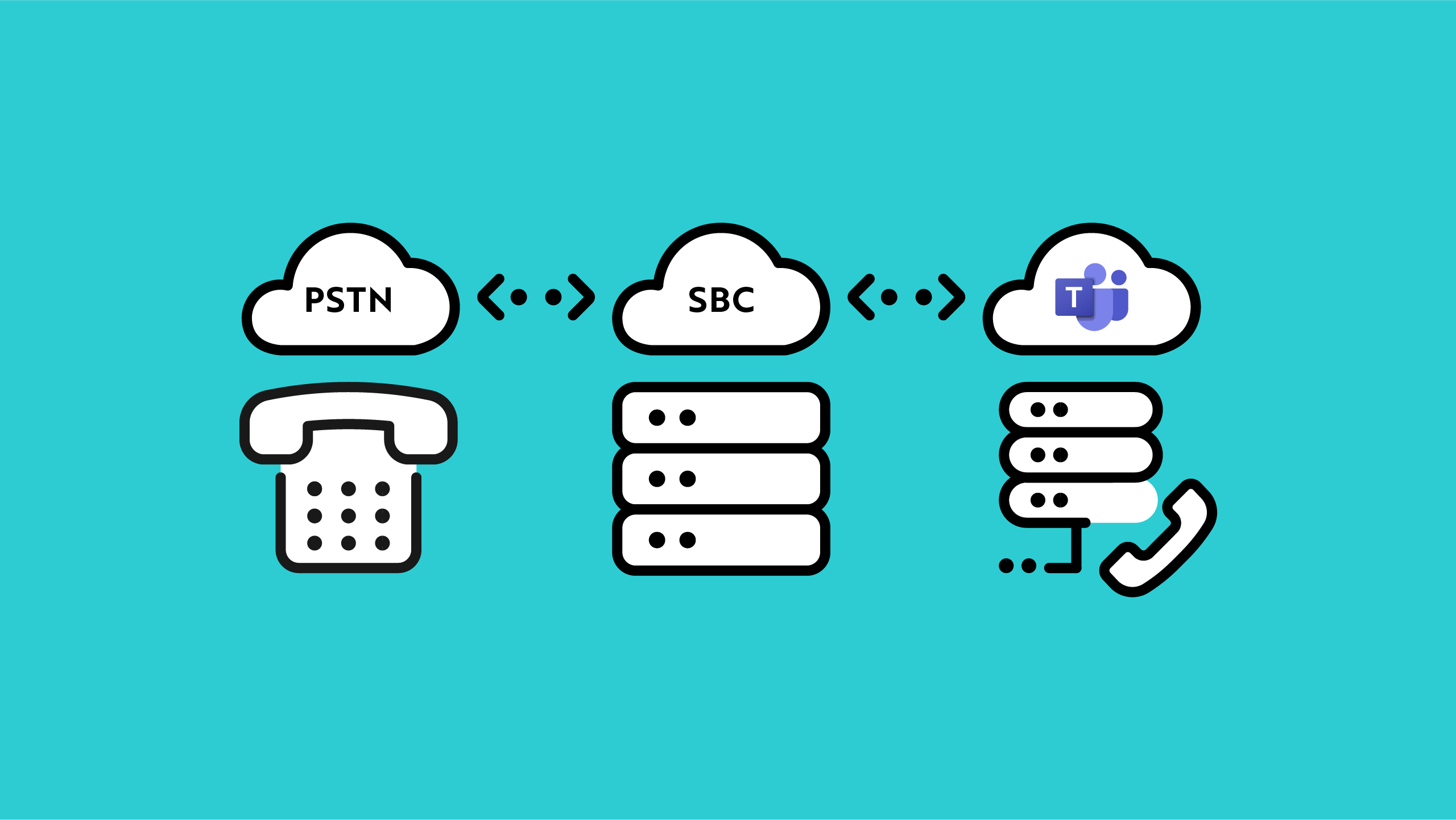
Microsoft Teams Direct Routing is an attractive option for many businesses looking to upgrade their phone system. The flexibility it offers is extremely appealing. But there is also a lot of risk and complexity to navigate. It can be hard to know where to start. In this article, I’ll give you an overview of Direct Routing, show you what to watch out for, and show you how to deploy it for your organization.
TL;DR
- Before you delve too deep into Direct Routing itself, you need to be prepared to learn an entirely new language, especially if your company still relies on a legacy PBX. This isn’t difficult, but the Teams Phone System is completely different from a traditional phone system.
- While there are several ways to set up PSTN connectivity through Teams, most businesses favor Direct Routing because of the flexibility it provides. You can choose your own provider and will most likely get a better user experience.
- That said, Direct Routing isn’t a magic silver bullet that will work seamlessly and solve all your business needs on its own. Without a trusted partner in your corner, you are still subject to all the challenges that come with Teams Phone, like Microsoft outages and a lack of advanced calling functionality.
- Deploying Microsoft Teams Direct Routing isn’t easy, but you can make it flawless by following the steps in this article.
- ZIRO can help answer your biggest questions and help you set up Direct Routing flawlessly.
The days of an on-premises legacy phone system are dwindling.
They might not be dead yet, but the surge of organizations that have moved to the cloud is growing quickly.
And it’s no wonder many of them are turning to Microsoft Teams Phone to replace their current phone system. Many companies already use Teams for messaging, meetings, and file sharing. By the end of 2020, Microsoft Teams had more than 115 million daily active users.
If you’re already using Microsoft for everything else, why wouldn’t you move your old-school PBX into Teams? In doing so, businesses unify their communication and collaboration, two essential pieces of remote and hybrid working.
While there are several different ways to use Microsoft for your telephony needs, one of the most popular options right now is Direct Routing.
It’s a way to provide a Public Switched Telephone Network (PSTN) connection to your Microsoft Teams users so they can make and receive external phone calls on any device using Teams.
Are you interested in understanding this technology and how to set it up for your organization? If so, read on. But before we can dive deep into Direct Routing, it’s important to take a step back and understand the Teams Phone System as a whole.
Understanding the Teams Phone System
If you’re an IT professional working in a Cisco CUCM or similar environment, the Teams Phone System might have you raising your eyebrows more than you’d expect.
Yes, all phone system migrations are difficult. But as a predominately software-focused company, Microsoft is quite different from your traditional phone system in some significant ways.
You need to be prepared to throw out the old telecom playbook and learn Microsoft’s ‘language’.
For example, in the traditional telephony world, you would assign an extension or a directory number to someone. With Microsoft, this has been replaced by the Line Unique Resource Identifier (URI), which is in the E.164 format (a US number in this format would look like this: +16175551212). In Teams, you’re typically calling users by clicking on their name (i.e. click-to-dial), so extensions aren’t enabled or set up by default.
If you have a legacy PBX or Cisco Unified Communications Manager (CUCM), you’re likely very familiar with Hunt Groups. Microsoft Teams refers to these as ‘Call Queues’.
And when you look at the backend, it’s a completely different ballgame. You no longer build a dial plan and assign access rights like you would with Call Manager (remember Calling Search Spaces, Route Patterns, and Route Lists?). With Teams, you’ll be using phrases like Voice Policies, Dial Plan Policies, and PSTN Usages.
Microsoft offers devices too, so your users can get physical phones if they need them. But those phones are just physical Teams clients. Microsoft’s software runs on the phone, and users always need to log into the phone to use it.
While many of these changes can be a bit jarring, there are a lot of Microsoft innovations to be excited about. Channel-Based Call Queues are a good example of this. They merge the concepts of messaging and telephony so calls can automatically reach all members of a Teams channel.
Nonetheless, moving to Teams can feel like a huge paradigm shift. This can all make upgrading to Teams Phone extremely risky.
Know Your Options
Teams Phone offers several different PSTN connectivity options:
Microsoft offers businesses lots of different options to suit their needs, which is great. But with choice does come complexity and confusion.
What is Microsoft Teams Direct Routing?
Internal and external business telephone calls have been traditionally delivered using a Private Branch Exchange (PBX), which is often located on the business premises.
And for a while, this technology served its purpose. But today, all that hardware requires constant maintenance. And in this post-pandemic world, businesses must get more done with less.
Microsoft Teams can replace your existing PBX in its entirety. You can eliminate the associated hardware and costs while simultaneously integrating your phone system with the rest of your Microsoft 365 investment.
Direct Routing makes this all possible while giving you the flexibility to choose your provider and customize your solution to fit your unique business needs.
Microsoft Calling Plans vs. Direct Routing
Direct Routing is like Microsoft’s own Calling Plans in a few ways. Both let you enable PSTN calling, and both let you enable voice communications through Teams.
With Direct Routing, however, you get to choose your own telecom provider. This is in sharp contrast to the Microsoft Calling Plans, where Microsoft acts as the PSTN carrier and provides the connection from Phone System to the public telephone network.
What CAN Direct Routing do for you?
In general, Direct Routing offers more flexibility and a better user experience than Microsoft Calling Plans do.
By default, Session Border Controllers (SBCs) required for Direct Routing are deployed on-prem and managed by the customer. However, certain telcos or partners (like ZIRO) offer Managed Hosted SBC services to offload this from the customer.
Microsoft isn’t a specialized calling company — they’re a software company. With Direct Routing, there’s room to work with a partner that lives and breathes this stuff.
What CAN’T Direct Routing do for you?
If you’re not a Microsoft customer, Direct Routing (and Teams Phone as a whole) might not be a good fit for you. After all, as you can probably guess, it all works best in tandem with the entire Microsoft ecosystem.
And because Direct Routing is a Microsoft feature, outages could impact your communications.
Finally, Direct Routing is complex and difficult to implement, especially on your own. From our experience, Microsoft’s support in this area is lacking, and it isn’t easy to find resources online that will precisely address your own unique business problems and needs.
But despite all that, Direct Routing is still our recommended solution for companies looking to upgrade their phone system, especially for large legacy environments.
How to Deploy Microsoft Teams Direct Routing
If you’re ready to implement Direct Routing and want to know what to expect, here is an overview of how to deploy it for your organization.
Remember: Direct Routing is complex. Some of these steps could require anywhere from 20-100 sub-steps, depending on your configuration. If you want a more detailed plan specific to your organization, we can help you do that – just get in touch.
We’ll also assume you already have implemented Teams in your organization. If that’s not the case, we recommend starting here.

How ZIRO deploys Microsoft Teams Direct Routing.
Step 1: Assess your Environment
Before you do anything, we recommend getting a complete understanding of what you have and use today. If you have a Cisco CUCM environment, we have a free CUCM to Teams Assessment you can get right now.

Step 2: Connect your Session Border Controller (SBC) with Teams Phone and Validate the Connection
This is one of the most difficult steps in the process, as there are lots of settings to configure. Some of these settings include things like the Fully Qualified Domain Name (FQDN), SIP signaling port, and location-based routing parameters.
This process can be completed in the Microsoft Teams Admin Center, through the graphical user interface (GUI), or through PowerShell (groan).
Of course, this only covers the Teams’ side of the integration. Your SBC also needs to be properly configured according to your vendor’s integration guide. Always make sure to use an SBC vendor and model which has been certified by Microsoft for Direct Routing.
Step 3: Enable users for Direct Routing, voice, and voicemail
Next, you’ll need to enable users for Direct Routing. To do so, follow these steps.
- Create a user in Microsoft 365 and assign a Teams Phone license.
- Configure the phone number and enable enterprise voice and voicemail.
- Assign Teams Only mode to users.
Step 4: Configure call routing
After enabling users, you need to configure call routing.
Just like a legacy PBX, the first step here is to properly plan and design a dial plan architecture that will meet your business requirements. The concepts are very similar – at the end of the day, a user is still dialing a phone number – but Microsoft Teams Phone System brings a slew of new terminology.
Building a dial plan in this platform requires the creation and configuration of call routing policies, PSTN usages, voice routes, and more. But just like the previous steps, this takes a lot of work and planning.
Step 5: Translate numbers to an alternate format
Sometimes, tenant administrators may want to change the number for outbound and/or inbound calls based on the patterns they created to ensure interoperability with Session Border Controllers (SBCs).
You can use the Number Translation Rules policy to translate numbers for the following:
- Inbound calls: Calls from a PSTN endpoint (caller) to a Teams client (callee)
- Outbound calls: Calls from a Teams client (caller) to a PSTN endpoint (callee)
Get Started with Microsoft Teams Direct Routing
As you can see, while Direct Routing is an excellent way to migrate your phone system to Microsoft Teams, there are many steps and decision points along the way.
As a solution provider with more than 12 years of UC experience, ZIRO can help! We make it simple and easy by working with you to create a foolproof plan for Teams Phone success.
Ready to get started or have questions? Book a free consult to get the answers you need.

Ready to take your unified communications from headache to hassle-free?
No throwing darts at proposals or contracts. No battling through the back-end. No nonsense, no run-around.


